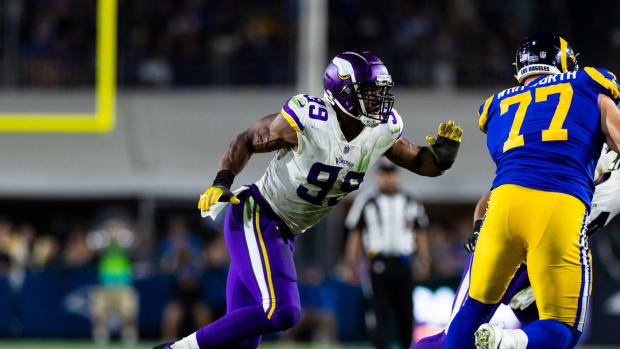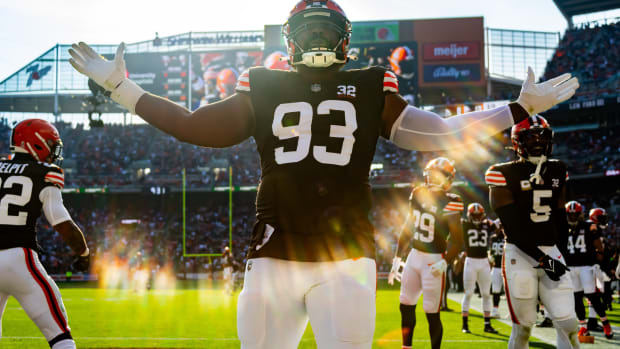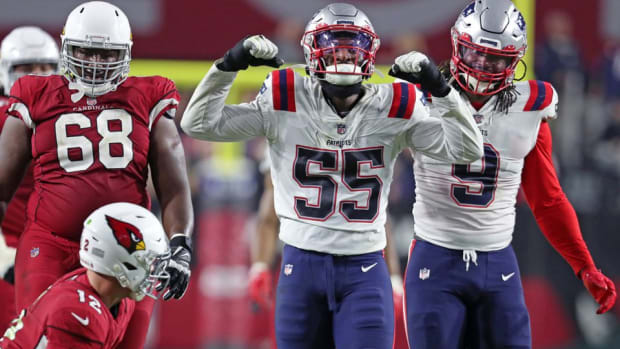Despite questions about his (water?) weight, Leonard Fournette proves that he's quick
INDIANAPOLIS — The offensive linemen were the opening act Friday. The running backs were the headliners.
Most of the big names took full part in the RB on-field workouts, wrapping their week in Indianapolis. Here’s some of what we learned:
Leonard Fournette, LSU: What a strange week for Fournette, who turned out to be the embodiment of why the combine overreaction cycle is so ridiculous.
This week has been on the strange side for Fournette, arguably the top RB prospect this year. It started with the weigh-in, where he tipped the scales at 240 pounds, then continued with this explanation for that number: “I drank a lot water before I weighed in. it’s water weight. It went away completely.”
The winding football journey of Krishawn Hogan, the only NAIA draft prospect at the combine
He said he thought he’d weigh 235, as he did at LSU. Five pounds of water weight, gone in the hours between weigh-in and interviews? Is that possible? I have no idea. To steal Cardale Jones’s line, “I ain’t come here to play school.”
Anyway, Fournette opened Friday with a dismal 28.5" vertical, among the worst RB marks—he told the NFL Network that was what he expected, saying, “I’m not jumper”—and then bowed out of the broad jump.
But lo and behold, when the 40-yard dash came around, Fournette shined, posting times of 4.51 and 4.52 seconds. Whether he’s at his goal weight of 235 or his human-waterbed 240, those are outstanding. Per the NFL Network, it was the fastest time by a 240-pound back (and Fournette officially counts there) since at least 2002.
Fournette showed throughout his college career that he could pull away in the open field and that he’ll lower the boom on a tackler. He’s special.
Dalvin Cook, Florida State: Cook was better in game action than he was in Friday’s combine action. That doesn’t necessarily mean Cook was bad, at all, during the on-field workouts, just that he fell short of blowing everyone away.
Cook ran a 4.49 40, which was 0.02 seconds better than Fournette. Whereas Fournette’s time will be viewed as a win, though, Cook’s could be a bit disappointing because a) he weighed 30 pounds less than Fournette and b) he looks closer to a 4.4 back on tape than a 4.5. Add in so-so marks in the broad jump (116") and vertical (30.5"), and an inconsistent showing in pass-catching drills, and teams may take a second look back at what Cook did as a Seminole just to make sure Friday was a bit misleading. (And an important note: As of the writing of this post, the three-cone and shuttle times had not been posted.)
The future of the NFL combine: How virtual reality and other new tech can change scouting
For most backs in this class, Cook’s performance would have been perfectly acceptable—just six other RBs topped his 40 time, for example. Cook entered with higher expectations because he is viewed as a challenger for the position’s top spot.
He won’t drop based on what happened Friday, but if there was ground between he and Fournette, he didn’t close it.
Christian McCaffrey, Stanford: Less than 24 hours after McCaffrey’s 10 bench-press reps drew a few jeers, the Cardinal star may have locked himself into a first-round selection. He boasted a 37.5" vertical to go with a 121" broad jump and 4.48 40—barely topping Cook’s time, lest anyone still be panicked over Cook. On top of that, McCaffrey may have been the most comfortable of all the backs during pass-catching drills.
How comfortable? Well ...
No, he’s not a strong, power back. He is what we knew he was all along: a quick-footed, all-around threat who should be able to thrive in the NFL if his offensive coordinator uses him creatively.
Alvin Kamara, Tennessee: Players never actually broad jump during a game, and rarely do they stop and leap vertically, so folks might wonder why these combine drills matter. The answer: They help NFL teams figure out how explosive players can be. With that in mind, Kamara probably made himself some money Friday—and showed why he had crept into the Round 1 conversation—with a group-best 131" broad jump and 39.5" vertical, both group-best marks.
“I think the league is moving more towards having running backs that can do more catching out of the backfield and do more things in the offense,” Kamara said this week, “and that’s what my game displays.”
His 40 time of 4.56 landed around the average for this year’s backs.
Dan Quinn reflects on a season defined by loss and where he'll take the Falcons from here
D’Onta Foreman, Texas: Conspicuous in his absence. Foreman, who slimmed down a dozen pounds from his college weight to 233, might have surprised a few people with his speed. Friday morning, though, multiple reports revealed that Foreman had been shut down from drills by the combine’s doctors, after they found a stress fracture in his foot.
For now, Foreman is expected to work out at Texas’ Pro Day on March 28, but we’ll see.
T.J. Logan, North Carolina: We can’t wrap on the running backs’ workout without mentioning the fastest among them. North Carolina’s 5’ 9”, 190-pounder blazed the Lucas Oil Stadium turf to the tune of a 4.37 40. That’s nowhere near Chris Johnson’s all-time combine mark of 4.24, but no other player Friday made it under 4.4.




































